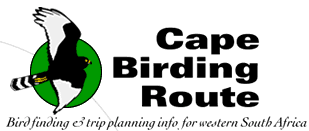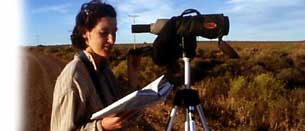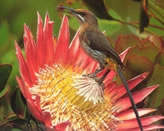Constantia
Greenbelts:
The forest patches which cloak much of the eastern slopes of
Table Mountain extend down into the exclusive residential suburb
of Constantia, south of Kirstenbosch (see regional map, p.14),
where interlinked ‘greenbelts’ have been set aside
to preserve the area’s natural character. The forest and
thickets along these greenbelts are the Peninsula’s best
sites to see the elusive Knysna
Warbler (p.32*), Buff-spotted Flufftail, Wood
Owl, and a host of other forest specials.
The
largest section of the greenbelts is known as De Hel (1 on
site map, below). Park in the small area next to the ‘Greenbelt’
signboard and walk to the right on the broad, descending path
which meanders down about 200 m to a small, vegetated stream
at 2. The upper reaches of this stream can also be reached
100 m further along the path that leads from the left of the
parking area (3). The secretive Knysna
Warbler is found in the streamside thickets, where
it creeps around low in the vegetation, often walking on the
ground. This sombre skulker’s strikingly beautiful song
is the key to pinpointing its position, and tape playback
often entices it closer. Excessive playback, however, can
cause disturbance to the birds and we urge birders to act
considerately — please don’t use calls unnecessarily.
Look out for Cinnamon Dove walking noisily on the forest
floor in this area. Other birds seen regularly between here
and the parking area include Cape
Siskin (p.33*), Forest Canary, Cape Batis,
Sombre Bulbul, Dusky and Paradise Flycatchers,
Rameron Pigeon, Redchested Cuckoo (vocal from
September to December), Lesser Double-collared Sunbird
and the introduced Chaffinch
(see box, p.31). This is also one of the few sites on the
Peninsula where Bar-throated Apalis and Swee Waxbill
occur, although they are scarce here.
Another
good part of the greenbelts for Knysna
Warbler is at 4 (again, park at the ‘Greenbelt’
signboard). A footpath leads down the densely vegetated stream
along which the birds lurk.
Buff-spotted
Flufftail, a relatively recent
discovery on the Cape Peninsula, is another star bird of the
Constantia Greenbelt. This is a legendary skulker, and is
among Africa’s hardest birds to see. Males are best searched
for on summer nights when their ventriloquial, hooting call
emanates from dense tangles of vegetation, often from a position
up to 3 m above the ground. Park at the point where the greenbelt
crosses Brommersvlei Road (5) and walk west for 300 m to a
wooden bridge over a small wetland (6). In the evenings, a
number of Buff-spotted Flufftails can be heard calling
along a stretch from here up to the tar road that crosses
the greenbelt (7). Wood Owl, Spotted Eagle Owl
and the occasional Fiery-necked Nightjar can be heard
at night.
Both
Red-breasted Sparrowhawk and African Goshawk
are common throughout this area. This is an excellent spot
to get clear views of African Sedge Warbler, Burchell’s
Coucal (listen for its bubbling call) and Common Waxbill.
Cecilia
Forest (main entrance at 8), a walking spot popular among
Capetonians, consists predominantly of timber plantations
with small patches of indigenous forest holding out along
the streams. Chaffinch and Cape
Siskin (p.33*) are particularly common in the plantations,
and the open patches with a clear view of the skies are the
best places to look overhead for soaring Red-breasted Sparrowhawk
and the rare Honey Buzzard, interspersed among the
much more common Steppe Buzzard and the occasional
Forest Buzzard.
Raptorphiles
may enjoy the identification challenge posed by the resident
and migrant buzzards. Forest Buzzard is a rare resident
of the Peninsula’s forests, and is best seen at Tokai
Plantation (take the Tokai off-ramp from the M3 and continue
all the way to the mountain, turning left, at the Cape Dutch
manor house T-junction, towards the Arboretum). The migrant
Steppe Buzzard far outnumbers it during summer, and
considerable skill is required to distinguish the two species.
It is also always worth keeping an eye out for the scarce
Honey Buzzard, whose presence in the Cape was revealed
only in the mid-1980s, when it was discovered by John Graham
at Tokai. Small numbers of this species can be found anywhere
in forests on the Peninsula, although Tokai and Cecilia Forest
are the places where they are seen most frequently.
|


